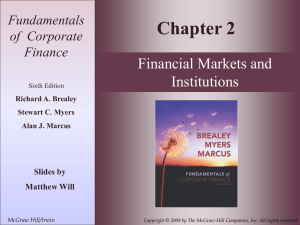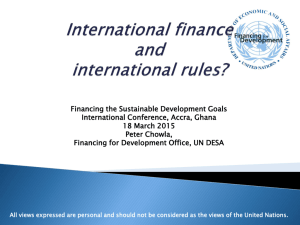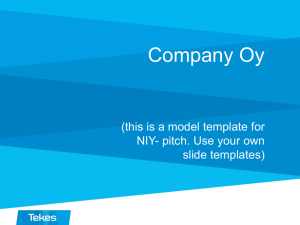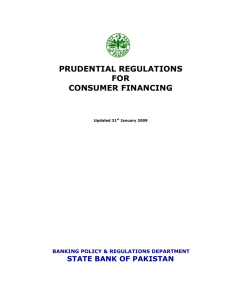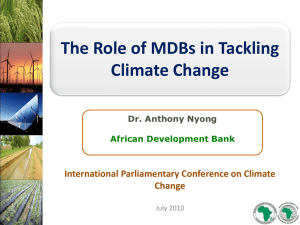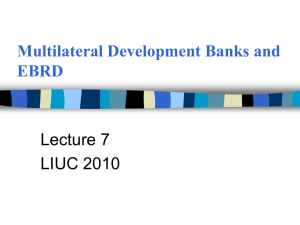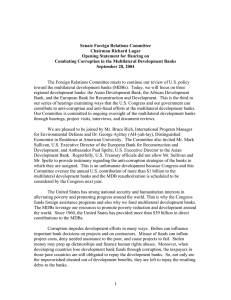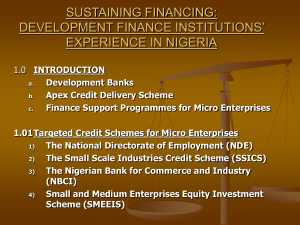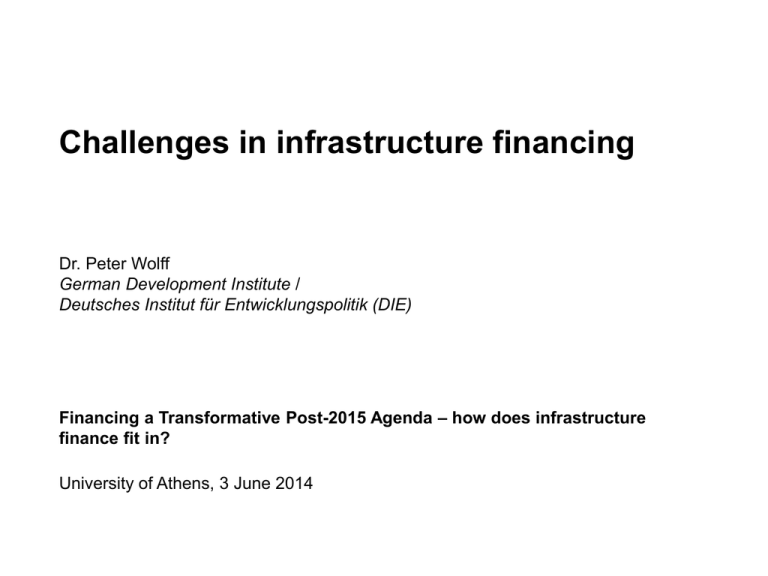
Challenges in infrastructure financing
Dr. Peter Wolff
German Development Institute /
Deutsches Institut für Entwicklungspolitik (DIE)
Financing a Transformative Post-2015 Agenda – how does infrastructure
finance fit in?
University of Athens, 3 June 2014
Outline
• Infrastructure needs – finance gap
• G20 – Attempts towards global coordination
• Role of Development Banks and DFIs
• Impediments for Institutional Investors
• Way forward – overcoming the coordination failure
2
Infrastructure – key enabler for post-2015
transformation
• Economic transformation - alleviate growth constraints
• Social transformation - access to water, sanitation, energy for
the poor
• Environmental transformation - from high to low carbon
energy
3
Estimated infrastructure needs in developing
countries
Source: World Bank, 2013 (AFR=Sub-Saharan Africa, EAP=East Asia & Pacific, ECA=Eastern Europe & Central Asia, LAC=Latin America & the
Caribbean, MNA=Middle East/North Africa, SAR=South Asian Region)
4
Finance gap - infrastructure
Financial needs for closing the infrastructure gap, $ bn annually
5
Effective provision of infrastructure - lower
cost
Infrastructure productivity: How to save $1 trillion a year
(McKinsey 2012)
•
•
•
•
•
governments: clarity about roles and priorities
streamlining delivery
improved operations (maintenance)
benchmarking construction and operational costs
brownfield vs greenfield investments
=> Policy framework and institutional capacities determine
financing needs
6
Challenges of infrastructure financing
High upfront capital requirements – investment in fixed assets
under uncertainty
Complex risk profile (macroeconomic, political, technical,
construction, revenue)
High return expectations by private investors – affordability?
High contingent liabilities for the public sector
7
G20 – attempts towards global coordination for
infrastructure investment
Seoul Multi-Year Action Plan on Development (2010) -„…overcoming
obstacles to infrastructure investment…“
Cannes Summit (2011) – Report of HLP on infrastructure investment
Los Cabos Summit (2012) – emphasis on engaging the private sector in
infrastructure investment
St. Petersburg Summit (2013) – establishment of WG on long-term
investment
Brisbane Summit (2014) – „move beyond the rhetoric…deliver tangible
outcomes“ (PM Abbott)
8
HLP on Infrastructure Investment –
Recommendations (2011)
• Ensuring a strong and sustainable supply of bankable projects - “…the
constraint is less one of funding than an insufficient pipeline of bankable
projects.”
• Contributing to building an enabling environment – “…the private sector
will not invest in the dark…”
• Making funding available under appropriate terms - local currency
debt markets (infrastructure bonds), local financial intermediaries,
MDBs: crowding in private capital through the use of risk mitigation
instruments, co-financing by Institutional Investors, SWFs
• Working with MDBs to identify a set of exemplary projects –
identify exemplary regional projects
9
Multilateral Development Banks
Infrastructure Action Plan (2011)
1.
Improving Project Preparation Funds (PPFs) Effectiveness
2.
Developing Catalytic Regional Projects
3.
Expanding Technical Assistance through expanded PPP practitioners‘ networks
4.
Increasing incentives for MDB staff to engage in PPP transactions and regional
projects.
5.
Piloting an Africa Infrastructure Marketplace
6.
Improving Procurement Practices to Facilitate Collaboration with the Private
Sector and amongst MDBs.
7.
Launching a Global Infrastructure Benchmarking Initiative
8.
Scaling up the Construction Sector Transparency Initiative (CoST)
10
11
Capacity of Development Banks and DFIs is
under-utilized
• Commercial banks face consolidation challenges and
regulatory boundaries => restrained credit growth – short-term
horizon
• Development Banks and DFIs to provide the necessary credit
enhancement products for project financing => grants, equity,
long-term debt, subordinate debt, first loss in structured funds,
securitization of future revenue streams, credit guarantees, viability
gap funding
• Development Banks and DFIs are instrumental in ensuring
effective project selection and development as well as positive
developmental effects of infrastructure investments =>
environmental, social, governance standards, “safeguards”, pricing
and regulatory policies
12
Infrastructure projects require a mix of funding
sources
Source: Martin, Matthew (2014): Public-Private Partnerships: a Desirable Way to Fund Development?
13
Challenges and Barriers to Infrastructure
Investing
G20-OECD working group on long-term financing
Source: OECD Pension Fund Investment in Infrastructure: Policy Actions, Working Paper 2011
14
Impediments for institutional investors
Reporting standards
Performance measurement
Benchmarking
Regulation (Solvency II):
Infrastructure Investment in Developing Countries =
alternative investment (high capital requirements)
Ways of investment:
Direct
Indirect
• listed funds
• unlisted funds
15
Way forward – overcoming the coordination
failure
• Developing local capital markets – more effort to create incentives
for local financing/local currency bond markets
• Closing the funding gap for project development – combine
domestic and external funds (grants)
• Closing the knowledge gap – MDB/OECD/private sector
collaboration (data, benchmarking, monitoring, learning platforms)
=> creating a new asset class for long term investors
• Collaboration between MDBs/DFIs/ECAs/SWFs – combine risk
taking capacities in co-financing arrangements; exposure exchange
agreements between IBRD and RDBs; IFC Asset Management
Company (AMC); World Bank Global Infrastructure Facility (GIF)
16
Thank you !
peter.wolff@die-gdi.de
17

